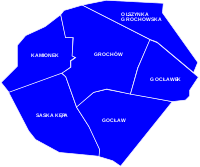Praga-Południe
| Praga-Południe | |
|---|---|
| coat of arms | |

|
|
| Basic data | |
| Geographic location : | |
| Population city : | 187,845 (2003) |
| Population density : | 8,386 inhabitants per km² |
| Area : | 22.4 km² |
| Website : | www.pragapld.waw.pl |
| politics | |
| Mayor : | Tomasz Kucharski |

|
|
Praga-Południe (German: Praga-Süd ) is a district of the Polish capital Warsaw on the eastern side of the Vistula . It belongs to the area of the former city of Praga , which included the older suburbs of Warsaw east of the river.
history
The area of today's Praga-Południe district has been inhabited since at least the 7th century. The traces of settlement are older than those found in Warsaw, but the swampy and often flooded area was abandoned when Warsaw was founded. It has been repopulated since the 16th century, but due to a lack of agreements with Warsaw, there was no permanent bridge over the Vistula until the 19th century and the suburb remained insignificant.
Praga-Południe developed similarly to the entire area of Praga . Part of Praga-Południe was used as a military camp in the 17th century. In the 18th century, part of the area was called Saska Kępa (literally translated: Saxon giants ) after the Saxon guards of the King of Poland stationed there .
The area retained its rural character until the early 20th century, when it only became part of Warsaw in 1916. Soon it was one of the fastest growing districts of Warsaw and the Saska Kępa district became its center. In the 1920s and 1930s, it became a popular residential area for Warsaw's middle class .
During and after the Second World War , the city district was largely spared from destruction. Contrary to some other plans, there was also no industrialization, which gave the city district much of its originally calm and peaceful character. There are currently some neighborhoods in which elaborately designed residential buildings are being built, but the authorities are not planning any further expansion and would like to preserve the character of the city district.
Aside from the architecture of Saska Kępa , the Skaryszew Park , Kamionek Lake and the Olszynka Grochowska Nature Reserve are some of the city's main attractions. The battlefield of the Battle of Grochów , fought in 1831 , and the small Wierzbicki Palace are also within the city district.
